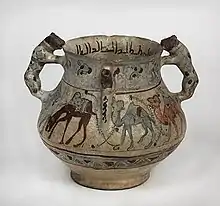Hagop Kevorkian
Hagop Kevorkian (Armenian: Յակոբ Գեւորգեան; 1872 – 1962) was an Armenian-American archeologist, connoisseur of art, and collector, originally from Kayseri, who graduated from the American Robert College in Istanbul, settled in New York City in the late 19th century, and helped America acquire a taste for Eastern artifacts.

He carried out excavations in Iran, at Sultanabad from 1903 and at the medieval city of Rey from c. 1907, and assembled an outstanding collection of Oriental art, especially Islamic and Persian. He organized the exhibition of Islamic ceramics in London in 1911. The works excavated under his supervision were shown in New York in 1914. Major sales of Islamic pieces from his collection, including lacquer doors and tile panels from Isfahan, books and paintings, carpets and ceramics, were held in the 1920s at the Anderson Gallery, New York. In 1929 he acquired at auction the Mughal album of calligraphy and painting that became known as the Kevorkian Album, now renamed "The Shah Jahan Album" by the Metropolitan Museum of Art (rather confusingly, as there is at least one other album called this). The Metropolitan Museum of Art in New York and the Freer Gallery in Washington, D.C. now hold elements of the Kevorkian Album in their collections.[1] An auction of some of his collection occurred in 1970 at the Parke-Bernet Galleries.[2]
The Brooklyn Art Museum's Kevorkian Gallery displays the Assyrian reliefs he donated to the institution. In New York, after Kevorkian's death, his foundation established the Kevorkian Chair of Iranian Studies at Columbia University.
New York University has a center named after him that houses its Middle Eastern studies department and library.[3] The Hagop Kevorkian Center for Near Eastern Studies at New York University was created in 1966 to foster the interdisciplinary study of the modern and contemporary Middle East and to enhance public understanding of the region.[4]
He was a major benefactor of the University of Pennsylvania Museum of Archaeology and Anthropology. Ninety-nine objects in the Penn Museum collections came from Kevorkian, either through purchase or, later, donation. He established a fund, the Kevorkian Fund, in the 1950s, which funded the expeditions of the University of Pennsylvania to Hasanlu, a site in northwest Iran inhabited from the 6th millennium BC, which Dr. Robert J. Dyson Jr., excavated. After his death the Kevorkian Fund also supported a visiting lectureship in Iranian art and archaeology and an international speaker series at the Penn Museum.[5][6][7]
References
- Bloom, Jonathan M.; Blair, Sheila S., eds. (2009). Kevorkian, Hagop in The Grove Encyclopedia of Islamic Art and Architecture. Oxford: Oxford Islamic Studies Online. doi:10.1093/gao/9781884446054.article.T046367.
- Parke-Bernet Galleries (1970). Property of the Kevorkian Foundation, Parke-Bernet Galleries, May 9, 1970 Auction. New York City.
- The Hagop Kevorkian Center
- The Hagop Kevorkian Center, National Resource Centers Archived July 27, 2011, at the Wayback Machine
- "Kevorkian, Hagop", Oxford Art Online, Oxford University Press, 2003, doi:10.1093/gao/9781884446054.article.t046367
- "Ralph Minasian and the Hagop Kevorkian Fund". Expedition. 60:1: 102. 2018.
- "Expedition Magazine". penn.museum. 1968. Retrieved February 18, 2019.
External links
- The Emperors' album: images of Mughal India, an exhibition catalog from The Metropolitan Museum of Art (fully available online as PDF), which contains material collected by Kevorkian
| Wikimedia Commons has media related to Hagop Kevorkian. |